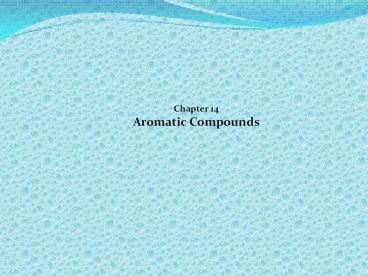Aromatic compounds - PowerPoint PPT Presentation
Title:
Aromatic compounds
Description:
Benzene produces only one monobrominatedcompound All 6 carbon-hydrogen bonds are equivalent in benzene Specific Electrophilic Aromatic : Substitution Reactions Side ... – PowerPoint PPT presentation
Number of Views:72
Avg rating:3.0/5.0
Title: Aromatic compounds
1
Chapter 14 Aromatic Compounds
2
- Benzene a remarkable compound
- Discovered by Faraday 1825
- Formula C6H6
- Highly unsaturated, but remarkably stable
- Whole new class of benzene derivatives called
- aromatic compounds
3
BENZENE Resonance description
- Later spectroscopic evidence showed all bond
lengths in benzene to be equal and intermediate
between single and double bond lengths (1.39 Å). - Resonance instead considers such molecules to be
an intermediate or average (called a resonance
hybrid) between several structures that differ
only in the placement of the valence electrons
4
Benzene-orbitals
It was also found that benzene was a flat
(planar) molecule.
5
Characteristics of aromatic compounds
- A delocalized conjugated p system, most commonly
an arrangement of alternating single and double
bonds Conjugated - Coplanar structure, with all the contributing
atoms in the same plane - Contributing atoms arranged in one or more rings
- A number of p delocalized electrons that is, 4n
2 number of p electrons, where n0, 1, 2, 3, and
so on. This is known as Hückel's Rule.
6
Huckels Rule The 4n2 Rule
- Planar monocyclic rings with a continuous system
of p - orbitalsand 4n 2p electrons are aromatic(n 0,
1, 2, 3 etc) - Aromatic means substantial resonance
stabilization - Benzene is aromatic
- planar
- Cyclic
- orbital at every carbon 6 p electrons (n1)
- Benzene has 3 bonding and 3 antibonding orbitals
- All the bonding orbitals are full and there are
no electrons in antibonding orbitals benzene has
a closed shell of delocalized electrons and is
very stable
7
Aromatic compounds
Non Aromatic compounds
8
Nomenclature of Aromatic Compounds
- 1. Monosubstituted Benzenes
- a. IUPAC name
b. Common name
9
2. Disubstituted Benzenes
All disubstituted benzenes, can give rise to
three possible isomers. The differentiate between
the isomers, the relative positions of the
substituents are designated by number or, more
commonly, by the prefixes ortho (o 1,2), meta
(m1,3) or para (p1,4).
When the substituents are different, they are
listed in alphabetical order
10
- If one of the substituents is part of a parent
compound, then the disubstituted benzene is named
as a derivative of the parent compound.
Certain disubstituted benzenes are referred to by
their common names.
11
Reactions of Benzene
- Even though benzene is highly unsaturated, it
does not - undergo any of the regular reactions of alkenes
12
Reactions of Benzene
- Benzene can be induced to react with bromine if a
Lewis acid catalyst is present - The reaction is a substitution and not an
addition!
Benzene produces only one monobrominatedcompound A
ll 6 carbon-hydrogen bonds are equivalent in
benzene
13
Specific Electrophilic Aromatic Substitution
Reactions
14
Side-Chain Reactions of Aromatic Compounds
- a. Halogenation of an Alkyl Side Chain
b. Oxidation of an Alkyl Side Chain
15
Disubstituted Benzenes Orientation
- Orientation Effects of Substituents in
Electrophilic Aromatic Substitution
Meta directors Ortho , para directors
-NO2 -SO3H -COOH, -COOR -CHO, -COR -CN -OH, -OR -NH2, -NHR, -NR2 -C6H5 -CH3, -R (alkyl) -F, -Cl, -Br, -I































